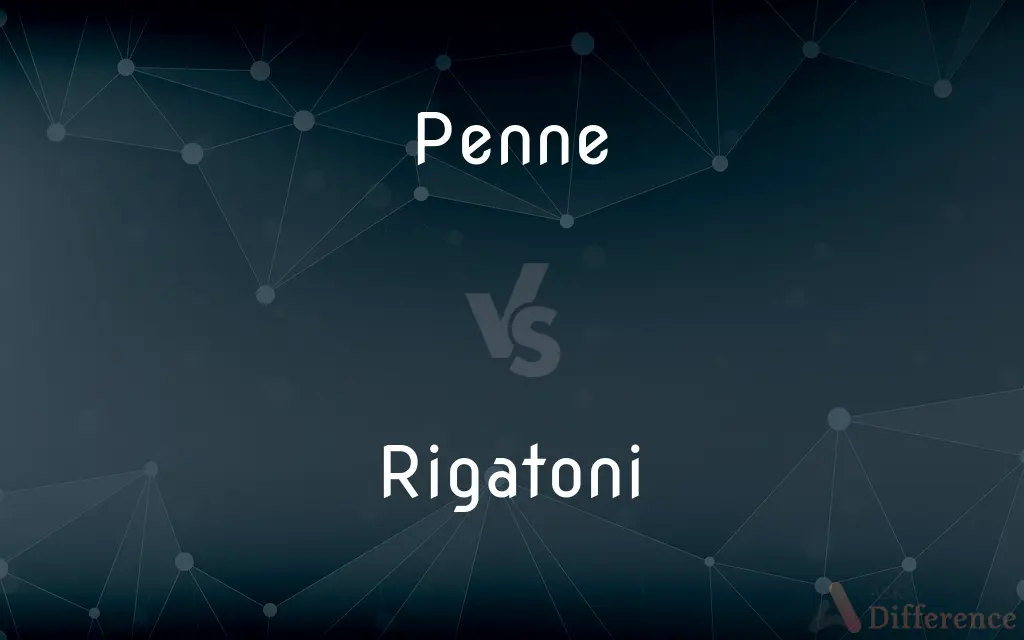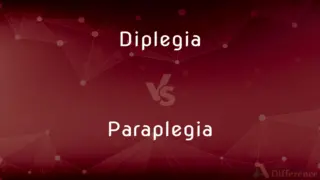Penne vs. Rigatoni — What's the Difference?
Edited by Tayyaba Rehman — By Fiza Rafique — Updated on November 2, 2023
Penne are tube-shaped pasta with angled ends, while rigatoni are larger, ridged, and cut straight across. Both are staples in Italian cuisine.

Difference Between Penne and Rigatoni
Table of Contents
ADVERTISEMENT
Key Differences
Penne is a type of pasta with a cylindrical shape, whose ends are cut at a bias to resemble the nib of an old feather pen, which is where it gets its name. This pasta is traditionally about 1.25 to 1.5 inches in length, with a diameter that is less than that of rigatoni. The angled ends of penne are designed to hold sauces and small ingredients, making it versatile in a variety of dishes.
Rigatoni, in contrast, are noticeably larger than penne and are cut straight across rather than at an angle. The ridges on rigatoni are also more pronounced than on penne, which may have a smoother surface or smaller ridges. These ridges are perfect for capturing thicker sauces, making rigatoni ideal for hearty meat sauces and baked pasta dishes.
The texture of penne is also a distinguishing factor. Penne pasta can come in two textures: “penne lisce” (smooth) and “penne rigate” (with ridges). The rigate variety is more common and is excellent for gripping onto creamy and oily sauces. The texture of penne offers a different mouthfeel, which can be slightly less hearty compared to the robust bite of rigatoni.
On the cooking front, both penne and rigatoni are boiled in salted water until they reach the desired level of “al dente.” The cooking time for rigatoni might be slightly longer due to its larger size and thicker walls. While both can be used interchangeably in many recipes, the choice between penne and rigatoni could hinge on personal texture preference or the type of sauce being served.
Comparison Chart
End Cut
Angled ends
Straight cut ends
ADVERTISEMENT
Size
Typically smaller and thinner than rigatoni
Larger and wider than penne
Ridges
Can be smooth or have smaller ridges
Characterized by deeper ridges
Sauce Pairing
Ideal for light to medium sauces
Better suited for thick, hearty meat sauces
Origin of Name
Named after a quill pen
Named for its ridged texture
Compare with Definitions
Penne
A type of pasta with angled ends and cylindrical shape.
She made a penne pasta salad for the picnic.
Rigatoni
Common in baked pasta dishes due to its size and texture.
Baked rigatoni with cheese is a comforting winter meal.
Penne
Can be "penne lisce" for smooth or "penne rigate" with ridges.
I prefer penne rigate for my pasta dishes.
Rigatoni
A pasta type that is heartier and offers a robust bite.
Hearty rigatoni pairs well with rich meat sauces.
Penne
Small pasta tubes ideal for holding creamy sauces.
Penne with alfredo sauce is his favorite dish.
Rigatoni
Large tube-shaped pasta with straight cut ends and ridges.
The rigatoni pasta was perfect for the bolognese sauce.
Penne
Pasta often used in baked dishes, like penne al forno.
The oven-baked penne was bubbling when it came out of the oven.
Rigatoni
Ideal for capturing thick sauces in their ridges and wide openings.
The rigatoni held onto the chunky tomato sauce beautifully.
Penne
Suitable for cold pasta salads due to their shape.
Penne is the preferred choice for her homemade pasta salad.
Rigatoni
Pasta that retains its firmness well, making it suitable for heavier dishes.
The rigatoni maintained a perfect al dente texture in the pasta bake.
Penne
Penne (Italian: [ˈpenːe]) is an extruded type of pasta with cylinder-shaped pieces, their ends cut at an angle. Penne is the plural form of the Italian penna (meaning feather but pen as well), deriving from Latin penna (meaning "feather" or "quill"), and is a cognate of the English word pen.
Rigatoni
Rigatoni (Italian: [riɡaˈtoːni]) are a form of tube-shaped pasta of varying lengths and diameters originating in Italy. They are larger than penne and ziti, and sometimes slightly curved, though not as curved as elbow macaroni.
Penne
Pasta in small short tubes with diagonally cut ends.
Rigatoni
Pasta in the form of short hollow fluted tubes.
Penne
A type of short, diagonally cut pasta.
Rigatoni
Pasta in ribbed, slightly curved, large-sized tubes.
Penne
Pasta in short tubes with diagonally cut ends
Rigatoni
A ribbed tubular form of pasta, larger than penne but with square-cut ends, often slightly curved.
Rigatoni
Tubular pasta in short ribbed pieces
Common Curiosities
Can penne and rigatoni be used interchangeably?
Yes, they can be substituted for each other in most recipes.
What is the typical length of penne pasta?
Penne pasta is typically about 1.25 to 1.5 inches long.
What does "penne" mean in Italian?
"Penne" is the plural form of "penna," meaning feather or quill, indicative of its shape.
Can rigatoni be used in pasta salads?
Yes, though its larger size and ridges are better for holding heavy dressings.
Is rigatoni more suitable for certain dishes?
Rigatoni is ideal for thick, hearty meat sauces and baked pasta dishes.
Does the size of rigatoni affect its cooking time?
Yes, rigatoni typically has a longer cooking time due to its larger size.
What's the difference between "penne lisce" and "penne rigate"?
"Penne lisce" are smooth, while "penne rigate" have ridges.
How do you prevent rigatoni from sticking together?
Stir rigatoni occasionally while cooking and use plenty of water.
Is penne considered a healthy pasta option?
Penne can be part of a healthy diet when portioned correctly and paired with nutritious sauces.
Are rigatoni always ridged?
Yes, rigatoni are characterized by their prominent ridges.
What types of sauces work best with penne?
Penne works well with light to medium sauces, like tomato or pesto.
What is the best way to cook penne to retain its shape?
Cook penne al dente, or firm to the bite, in boiling salted water.
Are penne and rigatoni vegan-friendly?
Yes, most traditional penne and rigatoni pastas are vegan, made with just flour and water.
Are penne and rigatoni both Italian?
Yes, both pasta types originate from Italy.
Do both penne and rigatoni come in whole wheat options?
Yes, both are available in whole wheat versions for a healthier option.
Share Your Discovery

Previous Comparison
Hindsight vs. Retrospect
Next Comparison
Diplegia vs. ParaplegiaAuthor Spotlight
Written by
Fiza RafiqueFiza Rafique is a skilled content writer at AskDifference.com, where she meticulously refines and enhances written pieces. Drawing from her vast editorial expertise, Fiza ensures clarity, accuracy, and precision in every article. Passionate about language, she continually seeks to elevate the quality of content for readers worldwide.
Edited by
Tayyaba RehmanTayyaba Rehman is a distinguished writer, currently serving as a primary contributor to askdifference.com. As a researcher in semantics and etymology, Tayyaba's passion for the complexity of languages and their distinctions has found a perfect home on the platform. Tayyaba delves into the intricacies of language, distinguishing between commonly confused words and phrases, thereby providing clarity for readers worldwide.















































